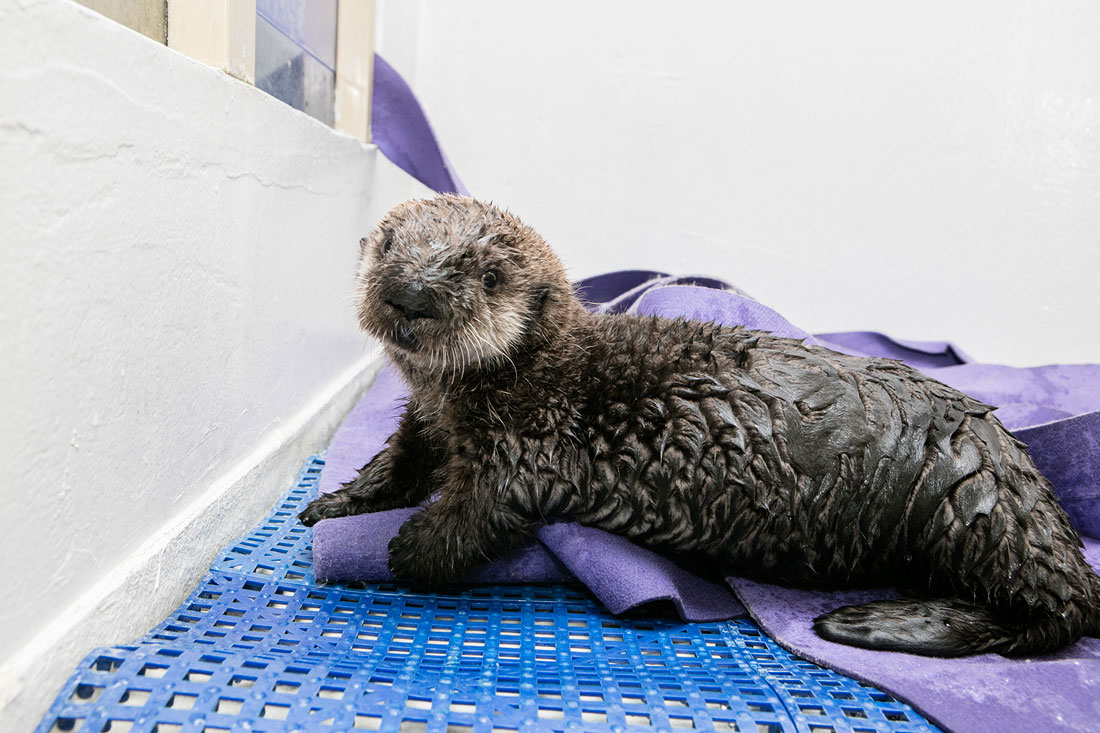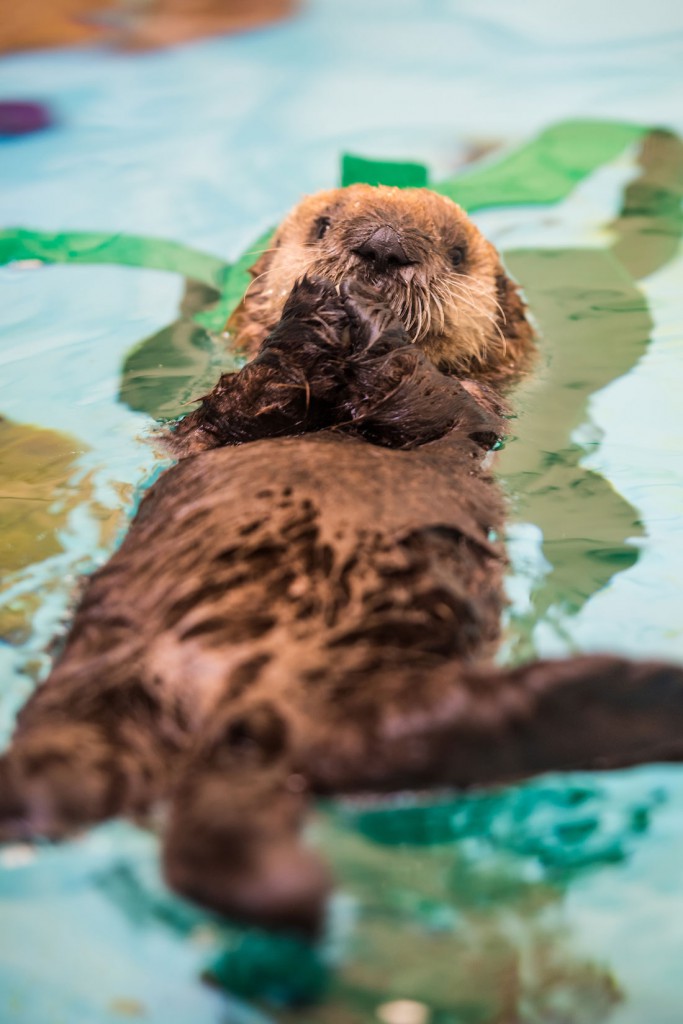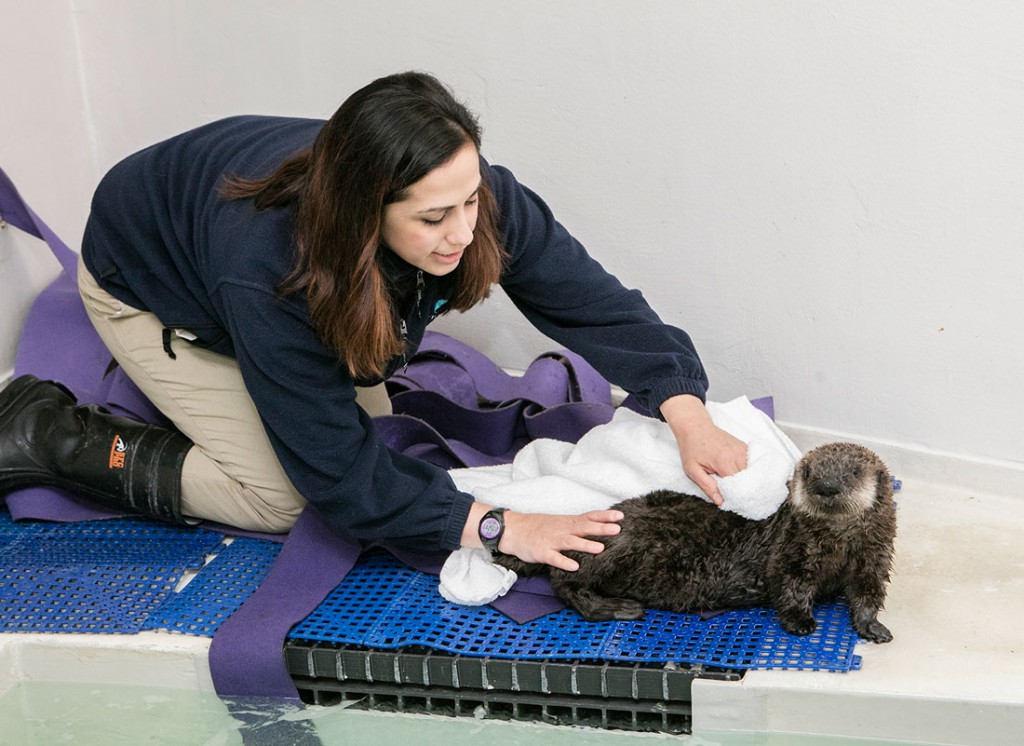By Claire Donnelly
Shedd Aquarium’s rescued sea otter pup is one lucky baby.
Pup 719 – as she is known until she gets a name – arrived in Chicago this winter after turbulent waves stranded her on a beach in California. The orphaned pup received almost two weeks of care at Monterey Bay Aquarium.
“Shedd was eager and ready to welcome pup 719,” said Tim Binder, Shedd’s executive vice president of animal care, in a post on the aquarium’s website.
Rescuers found the baby Southern sea otter early in January, lost amid crashing waves on Carmel Beach. They estimated that she was about four weeks old, based on her size, teeth and behavior.
The rescue team was unable to locate the pup’s mother, from whom she had likely been separated in the stormy waters. The Monterey Bay Aquarium brought the otter pup into round-the-clock care and nursed her back to health. The aquarium began referring to her as “719” since she was the 719th otter retrieved by its otter rescue program.
Monterey Bay’s program places orphaned otter pups with surrogate mother otters so the little ones can learn important behaviors and skills. But when pup 719 arrived, all of the surrogate mothers were already caring for other pups. So Monterey Bay decided to send 719 to Chicago for her permanent home.
“She’s a very robust and feisty pup,” said Karl Mayer, whose team spent many hours caring for her at Monterey Bay, in a post on the aquarium website.
Mayer said pup 719 was slightly ahead of the developmental curve when she was rescued, most likely because she was able to spend more time with her mother than pups who are stranded as newborns. Sea otters typically spend up to nine months learning survival skills from their mothers.
From the time pup 719 arrived at Monterey Bay, she was diving down to the bottom of her pool to retrieve food, rocks and shells, and was “very dexterous with her paws,” according to Mayer.
In Chicago, pup 719 has been receiving around-the-clock care from Shedd’s staff, and according to the aquarium website, she now weighs about 13 pounds.
The orphaned pup now grooms her own fur and is already skilled at hopping in and out of her pup pool without using the ramp. She is also able to eat solid food like shrimp, clam, squid and mussels. Her day starts with breakfast around 6 a.m.
“She’ll eat, then play, dive, be active, take a nice nap after all that activity, [and then] wake up and repeat the process,” said Christy Sterling, assistant supervisor of penguins and otters at the Shedd Aquarium, in a post on the aquarium website.
“It’s just so fun to watch her explore with boundless energy,” Sterling added.
Not all sea otters are as lucky as pup 719.
Today, the Southern sea otter species (Enhydra lutris nereis) is classified as “threatened” by the U.S. Fish and Wildlife Service. The animals are protected under the Marine Mammal Protection Act, which prohibits the harassing, hunting, capturing or killing of any marine mammal.
To have this official classification changed, the Southern sea otter population index would need to remain at 3,090 for three consecutive years. At its last count in 2014, the U.S. Geological Survey reported a population index of 2,944, a minor increase from 2013’s report of 2,939.
The sea otter population was severely decimated as a result of the 19th century fur trade. In fact, California otters were assumed to be extinct until the 1930s when a group of around 50 otters was spotted off the coast of Big Sur, according to the U.S. Geological Survey.
Sea otters are now facing additional environmental changes that may have an impact on their species’ ability to survive.
“The waves have been enormous,” said Mark Carr, a professor in the ecology and evolutionary biology department at the University of California at Santa Cruz.
These strong waves off the California coast are associated with El Niño, or the periodic warming of the tropical Pacific Ocean near the equator. Violent waves can separate otter pups from their mothers, which could have happened in the case of Pup 719.
Rough surf can also wreak havoc on the kelp beds where sea otters live.
According to Nate Mantua, a researcher at the National Oceanic and Atmospheric Administration’s Southwest Fisheries Science Center, El Niño causes these large waves in winter, a time of year when the ocean is already warm and nutrient-poor.
“[The] combination of nutrient stress on the kelp and the waves tends to be really hard on the kelp beds,” Mantua said in an interview.
If kelp cannot get the nutrients it needs to survive or is damaged by rough ocean waves, sea otter mothers and their pups can be forced to spend time in open water, offering less protection from predators.
While the destruction of kelp beds could impact the sea otter population, the threat is not immediate, said Tim Tinker, a research wildlife biologist at the U.S. Geological Survey Western Ecological Research Center.
“There [are] still plenty of kelp beds out there,” Tinker said. He explained that, for the sea otter population to be seriously affected, the kelp beds would need to be depleted by 80 or 90 percent. Right now, the destruction is nowhere close to that extreme.
Fun (and furry) otter facts
- Sea otters’ lung capacity is 2.5 times the size of land mammals of the same size.
- Sea otters use their whiskers to sense vibrations in the water.
- Sea otters don’t have blubber, so they eat 25 to 30 percent of their body weight in mollusks and other foods to maintain their high metabolism.
Information compiled from the U.S. Fish and Wildlife Service and Friends of the Sea Otter.
Another factor could affect the future of Southern sea otters: the availability of prey. Sea otters like to feast on their favorite meal – red and purple sea urchins. And they compete with sunflower sea stars (Pycnopodia helianthoides) for their food.
But a mysterious viral wasting disease has been ravaging sea star species on the West Coast, causing lesions, tissue deterioration and ultimately, death. The disease killed off the sunflower star species on most of the West Coast leading to an abundance of sea urchins, according to Carr.
“There’s suddenly all of this food,” Tinker said. “In the short term, that’s a bonanza for sea otters. They’re eating more urchins.”
Tinker and Carr hope that sea otters will be able to properly control the urchin population and return balance to their ecosystem. But there is also a danger that a separate bacterial wasting disease will begin killing urchins. The disease could spread quickly because of the unusually warm Pacific Ocean waters.
“This hasn’t happened yet, but it’s something there’s concern about,” Tinker said. “Viruses and bacteria love these sorts of [water] conditions.”
While the changing ocean conditions present various challenges for otters, Carr said there is no way to predict what will happen.

“I have no idea which of the scenarios may play out,” Carr said. “But it is indicative of the variable and unpredictable interactions of the ocean climate….among the species who live in the kelp forests.”
Regardless of what happens, the number of otter pups that get stranded in any given year is not the best measurement of the health of the population, according to Tinker.
“We do monitor changes in causes of death and the age at death over time,” Tinker said. “But the number of stranded pups [is] highly variable from year to year, and there are better tools for tracking environmental change.”
Tinker also pointed out that stranded pups are to be expected.
“It can be disturbing for people who find stranded pups. However it’s important to recognize that pup deaths are a normal part of sea otter biology,” Tinker said. “In a healthy population, only about 60 percent of pups will survive to weaning.”
If people find a stranded sea otter on shore , they should contact wildlife authorities.
At the Shedd Aquarium, pup 719 continues to demand a lot of care and attention, so she will be behind the scenes at the aquarium for the next few months.
The aquarium has not yet announced how they plan to name the new sea otter pup, but we at Medill News Service came up with a few suggestions, including “Annie,” “Harriet P. Otter” and “Sophie.”






